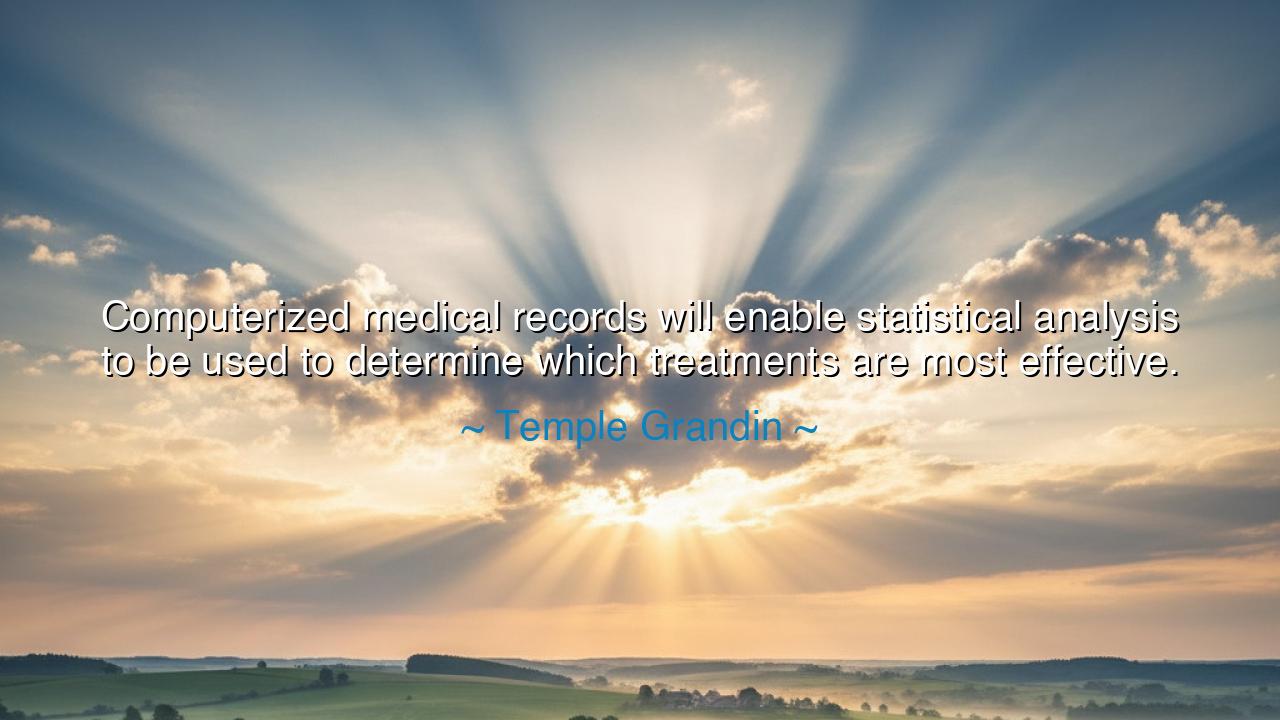
Computerized medical records will enable statistical analysis to
Computerized medical records will enable statistical analysis to be used to determine which treatments are most effective.






The words of Temple Grandin—“Computerized medical records will enable statistical analysis to be used to determine which treatments are most effective”—speak not only to the progress of technology, but to the awakening of a new age of understanding. Beneath the practical phrasing lies a vision both scientific and moral: that through the careful gathering of knowledge, humanity might move closer to truth in healing. Grandin’s statement, simple yet profound, is a reflection of her lifelong pursuit—to bridge the gap between data and compassion, between pattern and purpose. In her words, we hear the call to use reason not to replace the human heart, but to amplify its wisdom.
To comprehend the depth of this quote, one must first understand the speaker. Temple Grandin, a pioneer in both animal science and autism advocacy, has spent her life translating experience into structure. For her, order is not cold—it is the path to empathy. Her belief in the power of information and pattern arises from her own way of seeing the world: as a network of connections waiting to be understood. When she speaks of computerized records, she envisions a world where medicine learns from its own history—a vast collective memory where every diagnosis, every cure, every life becomes part of a greater map of healing. It is the dream of turning chaos into knowledge, and knowledge into care.
In ages past, the practice of medicine was often an art of intuition and chance. Physicians relied upon memory, experience, and fragments of wisdom handed down from teacher to apprentice. Great healers like Hippocrates or Galen observed patterns in the sick, yet their insights could not be shared instantly across borders or generations. Each doctor’s experience was confined to their own lifetime, each patient’s story lost when the breath ceased. But Grandin speaks of a revolution in that ancient craft—the creation of a collective intelligence, born from millions of stories preserved not in scrolls or memory, but in the living system of data. It is as if the old temple of medicine were given a thousand eyes, seeing what one healer could never see alone.
Consider the tale of Florence Nightingale, the “Lady with the Lamp,” who, during the Crimean War, transformed nursing not merely through compassion, but through statistics. She meticulously recorded deaths and illnesses, discovering that unsanitary conditions claimed more lives than battle itself. With charts and numbers, she convinced generals and ministers to change their ways. Her work marked the beginning of evidence-based medicine. Temple Grandin’s vision is a continuation of that same torch—where numbers serve life, where patterns in data reveal paths to healing that emotion alone might overlook. Just as Nightingale used her lantern to illuminate the dark corridors of suffering, computerized medical records become the modern flame that lights the way toward truth.
Yet Grandin’s words also carry a caution. Technology, like all tools of power, must be guided by ethics and empathy. The purpose of statistical analysis is not to reduce patients to numbers, but to see them more clearly through the patterns that unite all humanity. A doctor who forgets this risks becoming a mechanic of flesh rather than a healer of souls. The data may tell which treatments succeed, but it is wisdom—and compassion—that decides how they should be used. Grandin’s quote thus calls for balance: a marriage of logic and love, where science serves humanity rather than replacing it.
The deeper meaning of her message is timeless: that knowledge, when organized and shared, can become an instrument of justice. No longer should the poor suffer for lack of access, nor the sick be treated by guesswork. With collective data, the cures of one patient can guide the healing of another. The failures of yesterday become the wisdom of tomorrow. This is the democratization of medicine—a return to the Hippocratic ideal, where the healer’s duty extends not just to one body, but to all of humankind.
The lesson in Temple Grandin’s words is thus both practical and moral: let technology be the servant of compassion, not its master. Gather knowledge diligently, but wield it humbly. Learn from the patterns of life, but never forget the pulse that beats behind the numbers. Every patient’s story is sacred, and every record written in digital code is, at its heart, a testimony of hope.
So, my child, when you walk among the tools of modern medicine—when you see the machines, the screens, the endless data—remember Grandin’s vision. Do not see them as cold instruments, but as the voices of countless souls whispering their lessons to you. Use their wisdom to heal, not to control; to understand, not to exploit. For knowledge, when joined with mercy, becomes more than power—it becomes light, and through that light, humanity may yet fulfill its oldest promise: to ease the suffering of one another through truth, courage, and care.






AAdministratorAdministrator
Welcome, honored guests. Please leave a comment, we will respond soon